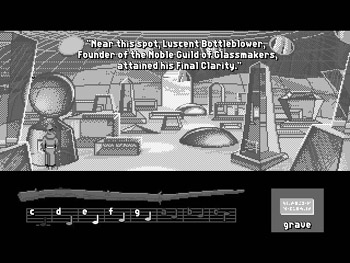Story
With the game mechanics focused in order to emphasize the game s storytelling component, the entire game would be for naught if the story Moriarty wished to tell was not of the highest quality. Fortunately, it is. The story of Bobbin Threadbare, the chosen Loom-Child whose task is to restore the fabric of reality, is one of simple beauty and great poignancy. On his seventeenth birthday, Bobbin is summoned before the elders , only to watch in amazement as they are transformed into swans. Dame Hetchel, the weaver who has been like a mother to Bobbin, explains to him the dire situation: the young weaver must discover what is slowly destroying the Loom and save it before it is too late. Thus Bobbin s adventure begins, with his trips to the various guilds of the land of Loom , drawing to a unique climax complete with a bittersweet ending. Along the way bits of the trademark, wise-cracking LucasArts humor are included (a style of humor found at its most intense in The Secret of Monkey Island ), though never so much that it dominates the story. Some players might see the story as strictly aimed at children, but Loom is a children s game in the same way The Hobbit is a children s book, The Dark Crystal is a children s movie, or Bone is a children s comic book. All contain enough sophistication and intelligence that one does not need to be a child to enjoy them, merely childlike.

Much of Loom s success rides on the strength of its fantastic and whimsical story.
The story is ideally suited to the gameplay that Loom includes, with navigation and the spinning of drafts being players only actions. The gameplay and story are so well integrated that the gameplay ends up involving the player in the story far more than if the story were told in a non-interactive format. At the same time the story never seems contrived for the sake of the gameplay, as many adventure game stories do. The text in the story is kept to a bare minimum, never going into excessive detail about anything, allowing the players imaginations to fill in the holes. It is a story that is told well visually, with the players exploration and experimentation with the distaff matching the emotional temperament of the character they are playing, Bobbin Threadbare. Since Bobbin first acquires the staff at the beginning of the game, it makes logical sense that he would not yet be an expert at it. Thus players many failed attempts to use the drafts fit perfectly with Bobbin s character. This is in contrast to many adventure games where, though players are controlling an intelligent , experienced character, players must complete idiotic puzzles such as figuring out their character s password to log onto a computer system, when obviously the character being controlled would already know this information.
One problem with third-person adventure games, games where players see their character in the game instead of just seeing what that character would see, is that often the character in question has such a strong personality and appearance that it may be difficult for players to feel properly immersed in the game. If the character is too much of a departure from one players could see themselves being, players may become frustrated when that character speaks lines of dialog they would not say themselves or performs other stupid actions. Loom works around this problem by putting Bobbin Threadbare inside a cloak, with players only ever seeing his eyes. This keeps the main character anonymous enough that players could believe that, in fact, it is themselves inside that cloak . At the one point in the game where Bobbin takes off his hood, the game quickly cuts away to a different scene, almost poking fun at the continued anonymity of the main character. And Bobbin s dialog is kept level and anonymous enough that he never says anything that might annoy players. Many game developers and publishers speak of creating strong characters , perhaps ones that can be used for action figures and movie rights later on. But what often keeps a game enjoyable for players is a more anonymous character ” one players can sculpt in their minds into their own idea of a hero.
EAN: 2147483647
Pages: 189